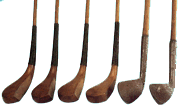A History of the Golf Club
Early Golf Clubs
In the earliest days of golf on the eastern coast of Scotland, players used primitive equipment to play the game in a rather haphazard and casual manner. While players initially carved their own clubs and balls from wood, they soon turned to skilled craftsmen to produce competitive equipment.
 The earliest reference to a set of specially made clubs is when King James IV of Scotland commissioned a bow-maker in Perth to make him a set in 1502.
The earliest reference to a set of specially made clubs is when King James IV of Scotland commissioned a bow-maker in Perth to make him a set in 1502.
A set of clubs at the time consisted of a set of play clubs (longnoses) for driving, fairway clubs (or grassed drivers) for medium range shots, spoons for short range shots, niblicks (similar to today's wedges) and a putting cleek. After 1618, the Featherie golf ball was introduced which endured for more than 200 years.
(similar to today's wedges) and a putting cleek. After 1618, the Featherie golf ball was introduced which endured for more than 200 years.
![]() Club heads were made from tough wood such as beech, holly, pear and apple. Shafts were made from ash or hazel. The head was connected to the shaft using a splint and then bound tightly using leather straps. The cost, time and effort which went into making golf clubs priced them beyond the reach of the masses. The clubs especially long-noses and niblicks were also prone to breakage and a golfer could expect to break at least one club during a round. These factors meant that golf was typically associated with the upper echelons of society.
Club heads were made from tough wood such as beech, holly, pear and apple. Shafts were made from ash or hazel. The head was connected to the shaft using a splint and then bound tightly using leather straps. The cost, time and effort which went into making golf clubs priced them beyond the reach of the masses. The clubs especially long-noses and niblicks were also prone to breakage and a golfer could expect to break at least one club during a round. These factors meant that golf was typically associated with the upper echelons of society.
There was some experimentation with the club face. Some club-makers used leather and other materials in an attempt to increase compression and therefore distance. Others implanted metal and bone fragments into the club-face in an attempt to prevent shattering. Indeed, as early as 1750 some club-makers used forged metal heads for niblicks.
...next page...

